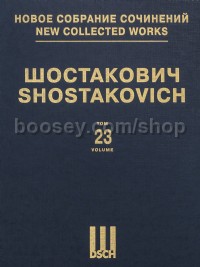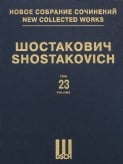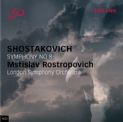Symphony No. 8, op. 65 - Piano Score (New Collected Works Vol.23)
Shostakovich, Dmitri
Symphony No. 8, op. 65 - Piano Score (New Collected Works Vol.23)
Shostakovich, Dmitri
Vol No: 23
Instrumentation: Orchestra (Piano Conductor's Score)
Publisher: DSCH Publishers
Catalogue No: M060130168
ISMN: 9790060130168
Shop Product Code: 269199G
$151.13 *
In Stock: Usually despatched within 24-48 hours
* Estimated price converted from UK retail price
Click below to view music sample pages


The first edition of the full score of the Eighth Symphony appeared in 1946 (Muzgiz, Moscow and Leningrad 1946). In 1948, Muzfond printed a mimeographed version of a four-hand piano arrangement done by Levon Atovmian. The edition does not indicate the author of the arrangement. Leo Mazel points to Levon Atovmian in the Guide to Shostakovich’s Symphonies (see: L. Mazel, op. cit., p. 84). An unfinished manuscript of the eight-hand arrangement of the symphony for two pianos performed by Paul Lamm has also survived (the Glinka All-Russia Museum Association of Musical Culture [VMOMK], rec. gr. 32, f. 14).
Repertoire Note
Shostakovich’s Eighth Symphony is one of his grandest and purest symphonic utterances, and is considered by many to be one of his finest works. Written during the summer of 1943 when the battle between Hitler’s Germany and Stalin’s USSR had turned and the Nazis were beginning their retreat, it is not at all a triumphant piece but rather a tragic utterance on the broadest scale. Clearly at some obvious dramatic level it is a response to the horrifying events of the war. But it is a piece whose significance can be read in many ways and not just in terms of its dreadful historical context.
The work is cast in 5 highly contrasted movements (the model here is clearly Mahler) which taken together form an enormous lopsided arch. These movements sound very different but nearly every note of them grows with remorseless logic out of the very first bars at the opening of the symphony. To some extent, the first and last movements reflect one another, the finale recapitulating a number of ideas from the first movement but in a strikingly different way. In between come a pair of scherzos (echoes here of the double scherzo of the Sixth Symphony op.54). The first of these is a stormy and thunderous reworking of music first used in the Second Jazz Suite of 1938; but here music that had been trivial and entertaining becomes a frightening dance of death. The second scherzo – and the central movement of the symphony – is a relentless nightmare of a moto perpetuo, whichn sounds as though the composer’s imagination has been caught in the wheels of an unstoppable machine. The fourth movement is a monumental passacaglia, where the repeated ground-bass is taken from the openings bars of the first movement.
At the end of the finale, Shostakovich writes a long and painfully mysterious coda which is clearly a reworking of the equally mysterious coda to his earlier Fourth Symphony op.43, which at the time when he was writing the Eighth was still a forbidden work and pretty much unknown to anyone except the composer.
This ambitious series by DSCH, the exclusive publisher of the works of Dmitri Shostakovich, when complete, will run to 150 volumes.
Based on authentic manuscripts, accompanied by commentaries in Russian and in English, each volume contains new engravings, articles relating to the history of the compositions, facsimile pages of Shostakovich's manuscripts, outlines, and rough drafts.
Divided into 15 different "series" or genres, the edition will include nearly all the original works of the composer, and his instrumentation of music by Domenico Scarlatti, Beethoven, Schubert, Schumann, Mussorgsky, Rimsky-Korsakov, Johann Strauss, Youmans, Braga, Tishchenko, and others.
25% of the New Collected Works will be made up of previously unpublished material: over 80 of his works are being published here for the first time. Many of these previously unknown works could not be published or performed during the composer's lifetime for ideological reasons.
The fifteen "series" within the edition comprise:
I: Symphonies (vols 1-30)
II: Orchestra Compositions (vols 31-37)
III: Instrumental Concertos (vols 38-49)
IV: Compositions for the Stage (vols 50-67)
V: Suites from Operas and Ballets (vols 68-72)
VI: Compositions for Choir and Orchestra (With or Without Soloists) (vols 73-83)
VII: Unaccompanied Choral Compositions/Arrangements of Russian Folksongs (vols 84-86)
VIII: Compositions for Solo Voice(S) With Orchestra (vols 87-90)
IX: Chamber Compositions for Voice and Songs (vols 91-97)
X: Chamber Instrumental Ensembles (vols 98-105)
XI: Instrumental Sonatas(vols 106-108)
XII: Piano Compositions (vols 109-115)
XIII: Incidental Music (vols 116-121)
XIV: Film Music (vols 122-145)
XV: The Works of Other Composers, Instrumentation by Shostakovich (vols 146-150)







